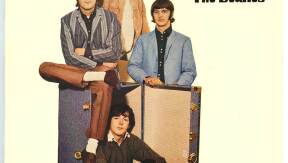To classify a guitar as being electric, it must include six strings, a neck, a body and one or more pickups. Despite these likenesses, there's a plethora of models each with their own identity. Let’s take a look at five legendary electric guitars that changed the history of music:
The Fender Telecaster
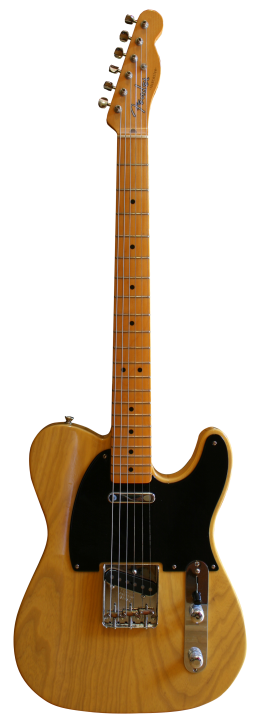
Considered the first solid-body electric guitar (solid wood body) and marketed on a large scale, it was born in 1949 from the hands of creator Leo Fender. Originally named Esquire, it was equipped with a single microphone in the neck. It changed its name several times before adopting "Telecaster" definitively in 1950.
Adopted by country guitarists, including Luther Perkins (Johnny Cash's soloist), it’s accompanied other big names like Keith Richards, Jeff Beck and Bruce Springsteen. Simple in style and makeup, its two single coil pickups and violin have an inimitable sound. There's even a word to define the flashy, metallic sound of the Telecaster: "The Twang."
Listen to the twang of the Telecaster:
The Gibson Les Paul
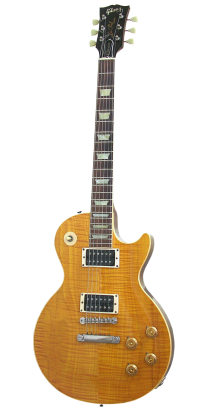
When Fender arrived on the market with its solid-body, the Gibson name was already well established in the guitar world. Considered as the reference for jazz musicians with its “hollow body," the guitar company never imagined the success of the "low end" models of its Californian counterpart.
But, following the success of the Telecaster and Stratocaster, Gibson changed its mind and teamed up with guitarist Lester William Polfus a.k.a. "Les Paul" to create its first full-body guitar in 1952. Unfortunately, success was not in the cards, pushing Gibson to end production in 1960.
It was during this decade that rock began to make waves and perk up ears. Little by little, guitarists like Mike Bloomfield, Eric Clapton and Jimmy Page came to see it as a powerful guitar with the perfect sound for wild solos and catchy riffs. Its status quickly emerged from oblivion to a “Rare Pearl" and its popularity rating soared to such an extent that Gibson revived production in 1968. It hasn't stopped since and to date, more than one hundred variations of the Les Paul and even more artists have made this their guitar of choice!
Listen to the resonance of the Les Paul:
The Fender Stratocaster

After the success of the Telecaster in 1954, the Californian guitar makers didn’t stop! Not a guitarist himself, Leo Fender used country music professionals, such as Bill Carson and Rex Gallion, to test and validate the options chosen at each stage of design of the Stratocaster. The goal was to create a model expressly for their needs.
The version included several improvements and patents such as cutaways for better balance, aesthetics with soft curves and easy access to the high notes. There’s even a third microphone in the central position for more sound possibilities and a whammy-bar (or vibrato) to play with the tension of the strings.
The three pickups of the Stratocaster allow it to have a sound palette. And just like its big sister, the Telecaster, there is a term to define the "Strat" sound: the "Jangly sound."
Thus was born the guitar that is considered today to be the icon of the electric guitar and that’s been seen in the hands of Jimi Hendrix, Buddy Holly, Eric Clapton and many others!
Listen to the "Jangly Strat" sound:
The Gretsch Guitars
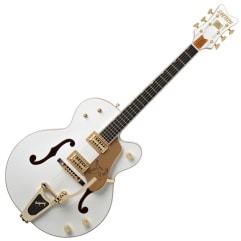
In the 50's, while Fender chose simplicity and innovation and Gibson proposed classic, high-end quality, Gretsch had no trouble offering luxury bling-bling guitars.
By partnering with the most famous country guitarist of the time, Chet Atkins, the brand embarked on a series of daring models. The gold hardware (metallic parts), the fancy glitter paintings or the pearly inlays, allowed Gretsch to stand out from the competition with a unique sound style and design.
What makes the strength and identity of Gretsch Guitars is the quality of the violin making, the acoustics and the use of the Filter'Tron pickups which gives a warmth and an inimitable richness of sound. First associated with country style, these six strings are equally at home in jazz, blues or rockabilly.
Guitarists like Brian Setzer, Jack White, Eddie Cochran, or Elvis Costello play on Gretsch Guitars.
Hear the warm sound of a Gretsch:
The Rickenbacker 325
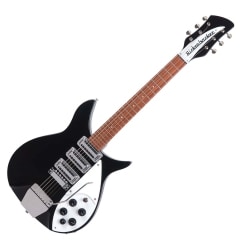
It’s 1960 in Hamburg, Germany, John Lennon, then unknown, discovered Toots Thielemans with a Rickenbacker 325 in his hands, and Lennon rushed to get his hands on one. He ended up playing a Rickenbaker at the start of The Beatles. The harmonics and crystalline sound of the 325 are perfectly heard on the first Fab Four albums, including the theme of A Hard Day's Night. Equipped with microphone toasters (their shape reminiscent of a toaster), Rickenbackers offer a clear and powerful sound as well as high note harmonies that are well-defined.
Listen to the crystalline sound of a "Rick:"

